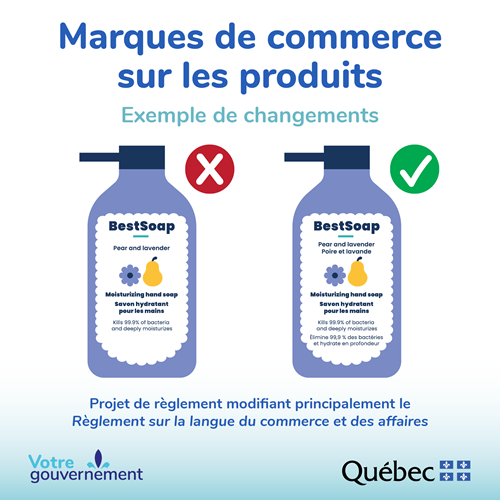On Jan. 10, 2024, the Québec government published its long-awaited draft Regulation to amend mainly the Regulation respecting the language of commerce and business (the draft Regulation).
If adopted in its current form, the draft Regulation would accompany Bill 96 (enacted on June 1, 2022), which introduced significant amendments to the Charter of the French language (the Charter). The impact of Bill 96 requirements has already been significant for those doing business in the province of Québec. It affects, in particular, all manner of advertising, including public signage, digital advertising, and product packaging and labelling. The draft Regulation was prepared with a view to support Bill 96 and to provide clarification of specific wording it contains. It also proposes to amend the Regulation respecting the language of commerce and business and to revoke the Regulation defining the scope of the expression “markedly predominant” for the purpose of the Charter of the French language. Key proposed changes affecting markings on products are discussed below. For insight on key proposed changes affecting public signage, please see here.
Markings on products
Current regime (applicable until June 1, 2025)
The general rule under the current regime is that any text (including text contained in a logo or trademark) appearing on a product, its container, its packaging, or any document or object supplied with it, must be displayed in French. While a translation in another language is permitted, that text may not be given greater prominence than the French text.
The general rule has several exceptions, including the “recognized trademark exception”. This exception allows for the display of non-French trademarks (such as English-only trademarks) – whether registered or not – on a product or its packaging without the need to translate the trademark in question into French. This example applies provided that the text is being used as a recognized trademark and a French version has not been registered.
Proposed amendments under Bill 96 (applicable as of June 1, 2025)
Under Bill 96, the “recognized trademark exception” allowing for non-French trademarks to be displayed is only available to registered trademarks, and not to unregistered trademarks.
In addition, Bill 96 requires that any generic or descriptive terms be also displayed in French on the product or its packaging – even if those terms are elements of a registered trademark.
Both new requirements are set to come into effect on June 1, 2025.
Draft Regulation (Published on Jan. 10, 2024)
The draft Regulation published by the Québec government proposes the following changes:
- “Registered Trademarks” will include trademarks that are the subject of pending applications: The draft Regulation proposes to broaden the definition of “registered trademark” to include a trademark for which an application has been filed but is not yet registered (i.e., a pending application). This amendment is proposed in respect of the "recognized trademark exception” applicable to trademarks displayed on products, containers, or packaging, but not to trademarks displayed on public signage or in commercial advertising. The latter are subject to different rules.
If this change is adopted, the “recognized trademark exception” described above will be available to owners of both registrations and pending applications for trademarks that are displayed on products or their packaging. This could be advantageous for those requiring longer lead times to render packaging compliant with these rules. This change would also help counteract extensive administrative delays at CIPO faced by applicants seeking to register their trademarks in Canada.
- Defining the scope of “generic” and “descriptive” terms to which translation requirements apply: Bill 96 requires the translation of any generic or descriptive terms appearing on products or packaging, even if these terms are elements of a registered trademark. The draft Regulation seeks to explain this aspect of Bill 96, by proposing that a generic term “refers to one or more words describing the nature of a product”, while a description (or a descriptive term) “refers to one or more words describing the characteristics of a product”.
How the Office québécois de la langue française (OQLF) – the governing body tasked with enforcing the Charter and its regulations – will interpret and apply these rules in practice remains unclear.
- Rules for generic and descriptive terms to which translation requirement apply will extend to associated packaging, documents and other objects: The draft Regulation clarifies that the rules governing the translation of generic and descriptive terms in French on a “product” also applies to the product’s container or packaging (wrapping) and to any document or object supplied with it. For example, warranty cards, user manuals and any embossments (containing text) must also comply with the same French language rules.
- Appearance requirements for French translations of generic or descriptive terms: Where generic or descriptive terms appear on a product or product packaging in a language other than French (regardless of whether they are elements of a registered trademark), such terms will need to be displayed in French without giving the non-French version of the terms greater prominence relative to the French equivalent, or making the non-French version available on more favourable terms.
According to this section of the draft Regulation, all descriptive or generic words that appear in a language other than French (including generic or descriptive words that are part of a registered trademark) and that require translation into French will need to be displayed at least at parity with the French version of those terms. The example below provided by the Québec government demonstrates its perspective on how compliance with this section of the draft Regulation may be achieved:

Source: Gouvernement du Québec
As can be seen from the above, to ensure compliance with the draft Regulation, the French translation of the scent features (“poire et lavande”) and properties of the product considered descriptive (“Élimine 99,9% des bactéries et hydrate en profondeur”) are added to the product packaging and appear in the same size and font as their English equivalent.
- Phase-out period for non-complying products: The draft Regulation proposes a two-year phase-out period, extending to June 1, 2027, to sell-off any products that are not compliant with the new French language requirements (Bill 96 and the Regulation), provided that the products in question were manufactured before June 1, 2025, and provided that no French version of the trademark appearing on the product in question was registered as of the date the Regulation is published in its final form. This change would allow any inventory of goods deemed non-compliant to be liquidated even after the coming into force of the amendments to Bill 96 and the Regulation.
Commercial documents
Current regime (applicable until June 1, 2025)
Under the Charter, any catalogues, brochures, folders, commercial directories, order forms or other documents of a similar nature that are made available to the public must be drafted in French. A version of these documents in a language other than French may also be provided as long as the French version is available on terms that are at least as favourable as the terms upon which the non-French version is made available.
Proposed amendments under Bill 96 (applicable as of June 1, 2025)
The draft Regulation clarifies that the “commercial documents” requirements of the current regime will also apply to websites and social media pages. This is in accordance with a position previously adopted by the OQLF.
How to prepare for coming into force of the regulation (if adopted)
While the draft Regulation is subject to a 45-day consultation period that commenced on Jan. 10, 2024, and is thus not yet in its final form, those doing business in the province of Québec may wish to take certain steps in advance to ensure that product packaging and advertising materials made available to consumers in the province of Québec are compliant with the requirements of Bill 96 and the draft Regulation:
- Ensure trademarks are registered or the subject of a pending application: Consider whether any non-French trademark that is displayed on a product or packaging is registered or should be the subject of a pending application. Consider whether applications for “common law” trademarks should be filed with the Canadian Intellectual Property Office.
- Review trademarks for the presence of generic or descriptive terms: Consider a review of existing pending trademark applications and registrations to determine whether they contain generic or descriptive terms as these terms will need to be translated into French, even if they are elements of a registered trademark. Compliance with the draft Regulations may require consultation with marketing departments who will need to plan on creating space for the French generic or descriptive term on labels – as such translated terms will need to be displayed at parity with the English version of those terms.
- Reviewing the language of the trademarks. In order for a product to benefit from the two-year phase out period allowing the sell-off of non-compliant products until June 1, 2027, there must not be a registered French version of the trademark appearing on the product as of the date of publication of the final form of the Regulation. As such, decision makers will need to carefully consider the consequences of filing an application to register the French version of a trademark.
Given that the OQLF considers a bilingual trademark (i.e., a trademark containing terms that are both in French and in English) to be a “French” trademark, businesses with pending applications for bilingual trademarks may wish to consider whether prosecution of those applications should be pursued or whether they should be abandoned in favour of a unilingual version.
Should you have any questions regarding the draft Regulation, Bill 96 requirements, the Charter of the French language, or their respective application in the province of Québec , we invite you to contact of the authors of this publication and key contacts in our Intellectual Property and Regulatory teams.




